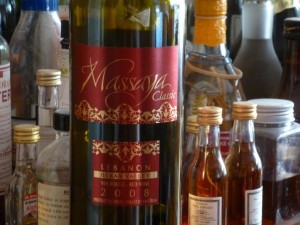Lighting A Fuse In Lebanon
 I was about to leave a wine tasting at Rogers Park Fine Wines & Spirits, when I noticed that half the people in line to check out had at least one bottle of Massaya Classic in their hands. Recently, I saw the Massaya Classic appear again, this time in In Fine Spirits‘ “tasting tournament.” It made it to the final four, at least. This obscure Lebanese red blend seems unlikely to remain obscure for long.
I was about to leave a wine tasting at Rogers Park Fine Wines & Spirits, when I noticed that half the people in line to check out had at least one bottle of Massaya Classic in their hands. Recently, I saw the Massaya Classic appear again, this time in In Fine Spirits‘ “tasting tournament.” It made it to the final four, at least. This obscure Lebanese red blend seems unlikely to remain obscure for long.
I wisely bought a bottle of the 2008 at the Rogers Park tasting, and I finally decided to open it and see what the fuss was about. The nose of red fruit, red meat and black pepper seemed promising, and indeed, it won me over at first sip with big, fruity flavors of cherries and plums followed by a peppery finish. I could see why this wine was so popular.
We paired it, perhaps in error, with some homemade pork tacos topped with guacamole, salsa, black beans, rice, cilantro and cheese. The wine became almost overpoweringly spicy, the black pepper kicking into overdrive. (I’m still working on a good red to pair with spicier dishes — if anyone has had any success beyond Lambrusco, please let me know.)
So what’s going on here? Is Lebanon poised to become a real player in the international wine markets? Although nowadays it’s associated more with Hezbollah and war, Lebanon has produced quality wine for thousands of years. Most of the vineyards (including Massaya’s) grow in the Bekaa Valley, where the ancient Romans erected a temple to Bacchus. Even then, this was major terroir.
As I noted in my post about the Massaya Blanc last May, for years, just five wineries in Lebanon sold wine in any quantity, the production stifled by years of civil war. In the last decade, however, the wine scene has exploded, and Massaya (which translates as “twilight”) is at the forefront. According to The Oxford Companion to Wine, “If one winery can be said to have lit a fuse under what was, until the mid-1990s, a sector that lacked a competitive edge, it is Massaya, a Franco-Lebanese alliance formed in 1997…”
As evidenced by its performance in the In Fine Spirits tasting tournament, the Massaya Classic competes quite fiercely. Its fruit-forward flavors likely come from the 60% Cinsault in the blend, the remainder of which is 20% Cabernet and 20% Syrah. This Grenache-like French variety usually appears only as a minor blending partner, used to add “suppleness, perfume and immediate fruit,” notes the Companion, but in Lebanon it forms “the backbone of the wine industry.” If Cinsault can produce charming wines like this Massaya Classic, I can see why the Lebanese are drawn to it!
Lebanon lives in a rough neighborhood. Syrian dogs of war nip at its heels even now. I can’t do much about that, but I can support its wine industry. The Bekaa Valley has delighted wine drinkers for centuries upon centuries, and we can help it continue to do so. If you happen to see a bottle of Massaya Classic (or Massaya Blanc, which I wrote glowingly about here) at your wine shop, I encourage you to pick it up, and taste some ancient wine history.
SUMMARY
2008 Massaya Classic: Ripe, with big fruit flavors and a black pepper finish. A good wine for a party, and a fine value. Chill in the refrigerator for about 20 minutes before serving.
Grade: B+
Find It: I purchased this bottle at Rogers Park Fine Wines & Spirits (6733 N. Clark at Pratt, tel. 773-761-1906) for $13, but you can also find it at In Fine Spirits and Binny’s.





